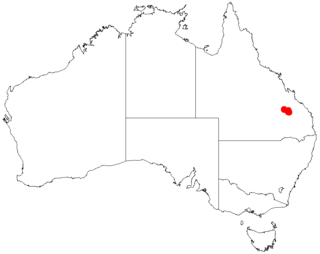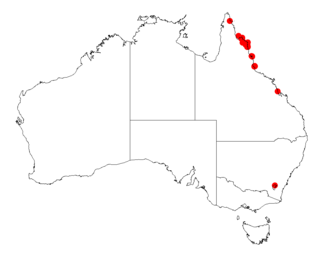
Acacia concurrens, commonly known as curracabah or black wattle, is a shrub native to Queensland in eastern Australia.

Acacia hispidula, known colloquially as little harsh acacia, rough-leaved acacia or rough hairy wattle, is a species of Acacia native to eastern Australia.

Acacia stipuligera is a tree or shrub belonging to the genus Acacia and the subgenus Juliflorae. It is native to arid and tropical parts of northern Australia.

Acacia rossei, also known as Yellowdine wattle, is a shrub of the genus Acacia and the subgenus Phyllodineae that is endemic to south western Australia.

Acacia hockingsii, also known as Hocking's wattle, is a shrub belonging to the genus Acacia and the subgenus Phyllodineae that is native to parts of north eastern Australia.

Acacia johnsonii, commonly known as gereera wattle or geereva wattle, is a shrub belonging to the genus Acacia and the subgenus Phyllodineae that is native to parts of eastern Australia.

Acacia polifolia is a shrub belonging to the genus Acacia and the subgenus Phyllodineae that is native to parts of eastern Australia.

Acacia saxicola, commonly known as Mount Maroon wattle, is a shrub belonging to the genus Acacia and the subgenus Phyllodineae native to eastern Australia.

Acacia leichhardtii, commonly known as Leichhardt's wattle, is a shrub of the genus Acacia and the subgenus Phyllodineae that is endemic to north eastern Australia.

Acacia caroleae, also known as Carol's wattle or narrow leaf currawong, is a shrub belonging to the genus Acacia and the subgenus Juliflorae that is native to north eastern Australia.

Acacia cretata is a shrub or tree belonging to the genus Acacia and the subgenus Juliflorae that is native to north eastern Australia.
Acacia argyrotricha is a shrub of the genus Acacia and the subgenus Plurinerves that is endemic to north eastern Australia

Acacia homaloclada, also commonly known as Hitchinbrook wattle, is a shrub of the genus Acacia and the subgenus Plurinerves that is endemic to north eastern Australia. It is listed as vulnerable according to the 1992 Nature Conservation Act.

Acacia johannis is a shrub of the genus Acacia and the subgenus Plurinerves that is endemic to a small area of north eastern Australia.

Acacia legnota, also known as heath wattle, is a shrub of the genus Acacia and the subgenus Plurinerves that is endemic to an area of north eastern Australia.

Acacia leptoloba, also known as Irvinebank wattle, is a shrub of the genus Acacia and the subgenus Plurinerves that is endemic to an area of north eastern Australia.

Acacia melvillei, commonly known as yarran, is a shrub of the genus Acacia and the subgenus Plurinerves that is endemic to south eastern Australia.

Acacia microsperma, commonly known as bowyakka, is a shrub of the genus Acacia and the subgenus Plurinerves that is endemic to an area of eastern Australia]. It is rated as least concern according to the Nature Conservation Act 1992.

Acacia racospermoides is a shrub or tree of the genus Acacia and the subgenus Plurinerves that is endemic to an area of northeastern Australia.

Acacia venulosa, commonly known as veiny wattle or veined wattle, is a shrub of the genus Acacia and the subgenus Plurinerves that is endemic to an area of eastern Australia.



















